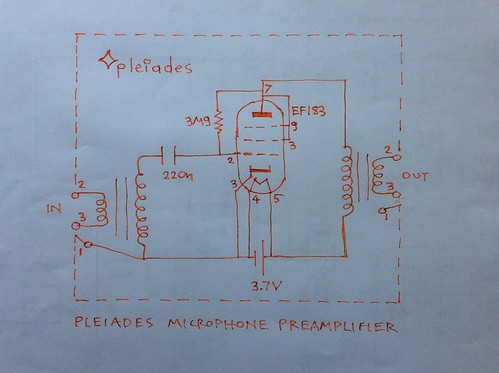What if a large singer mic distance is desired?
Provided acoustics can take it, which may mean small spaces with very good panel bass absorbers, large spaces, or quiet outdoor spaces...
Let's take an example of the 1H4 electron tube used as mic booster amplifier on the Pleiades V6 schematic:

Caution: Always use a suitable fuse in series with any battery for safety.
Cc is 22nF. Vh is 1.3V. A second, Vb=9V battery is connected between + of Vh battery and primary of output transformer.
Initially no pull up bias is connected from anode to grid. The grid is free at space potential.
A typical anode current is 10μA. The sound is very nice. The high plate or anode resistance creates a low cut, high pass filter with the inductance of the output transformer primary. So a directional microphone or even perhaps an omnidirectional with good low frequency response can be used at close distance 2-4in.
But what if more than a foot singer mic distance is desired to be used?
The sound would be thin.
A high megohm resitor can be connected between anode and grid to decrease the self negative bias of the grid by the emmited electrons from the cathode. As anode current is increased to say 50μA (depends on Rag) Plate impedance drops so the cutoff frequency also does. (Pull up bias can also,be done by connecting a resistor from grid to positive (by missing electrons) cathode, a lower value one).
The gain of the electron tube increases and noise goes down possibly because transconductnce increases.
So this should compensate the fact that there is less output from the mic being used further away.
A variable Rag could be used too.
This principle could be applied to other electron tubes such as 2DV4, 7586, 13CW4, EF183, 6AK7, 12SK7, UCC85, ECC82 etc.
No comments:
Post a Comment